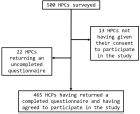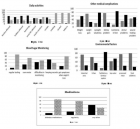Abstract
Short Communication
A trial of conservative care for restoring scapular dyskinesis: A clinical series
S Thiruvarangan*, P Srigrishna and B Thileebphan
Published: 08 June, 2020 | Volume 4 - Issue 1 | Pages: 011-015
The shoulder is the greatest movable joint in the human body. Its anatomical design allows a wide range of motion in all directions, leading to an insubstantial balance between stability and mobility. Conservative treatments are suggested by a number of authors for restoring the scapular dyskinesis. However, this condition can be overlapped by other clinical findings. Therefore, comprehensively analysing individual biomechanical rationale is central to design the ideal rehabilitation regimen to overcome scapular dyskinesis by restoring the scapular thoracic rhythm and preventing the associated problems. This study presents a brief clinical series of three patients with shoulder pain due to the alteration of their scapulahumeral rhythm and highlights a comprehensive examination and follow up an evidence-based rehabilitation algorithm to regain pain free functional ability in daily routine life.
Read Full Article HTML DOI: 10.29328/journal.jnpr.1001031 Cite this Article Read Full Article PDF
Keywords:
Scapular dyskinesis; Conservative approach; Scapular algorithm
References
- Feleusa MA, Bierma-Zeinstraa HS, Miedemab MD, Bernsena AN, Verhaard BW, et al. Department of General Practice Manual Therapy. 2008; 13: 426–433.
- Greving K. Incidence, prevalence, and consultation rates of shoulder complaints in general practice. Scand J Rheumatol.. 2012; 41: 150-155. PubMed: https://pubmed.ncbi.nlm.nih.gov/21936616
- Sciascia, AD. Clinical implications of scapular dyskinesis in shoulder injury: the consensus statement from the “Scapular Summit”. Br J Sports Med. 2013; 47: 877–885. PubMed: https://www.ncbi.nlm.nih.gov/pubmed/23580420
- Seitz AL, Mc Clure PW, Lynch SS, Ketchum JM, et al. Effects of scapular dyskinesis and scapular assistance test on subacromial space during static arm elevation. J Shoulder Elbow Surg. 2012; 21: 631-640. PubMed: https://pubmed.ncbi.nlm.nih.gov/21444218
- Smith R, Nyquist-Battie C, Clark M, Rains J. Anatomical Characteristics of the Upper Serratus Anterior: Cadaver Dissection. J Orthop Sports Phys Ther. 2003; 33: 449-453. PubMed: https://www.ncbi.nlm.nih.gov/pubmed/12968858
- Edward R, Laskowski ER, Newcomer-Aney K, Smith J. Refining Rehabilitation with Proprioception Training: Expediting Return to Play. Phys Med Rehabil Clin N Am. 1997; 25. PubMed: https://pubmed.ncbi.nlm.nih.gov/2008686
- Tyler TF, Nicholas SJ, Roy T, Gleim GW. Quantification of posterior capsule tightness and motion loss in patients with shoulder impingement. Am J Sports Med. 2000; 28: 668-673. PubMed: https://www.ncbi.nlm.nih.gov/pubmed/11032222
- Kibler W. Sciascia, A. Current concepts: scapular dyskinesis. Br J Sports Med. 2010; 44: 300–305. PubMed: https://www.ncbi.nlm.nih.gov/pubmed/19996329
- Burkhart SS, Morgan CD, Kibler WB. The disabled throwing shoulder: spectrum of pathology. Part III: The SICK scapula, scapular dyskinesis, the kinetic chain, and rehabilitation. Arthroscopy. 2003; 19: 641-661. PubMed: https://www.ncbi.nlm.nih.gov/pubmed/12861203
- Kent BE. Functional anatomy of the shoulder complex, a review. Phys Ther. 1971; 51: 867-887. PubMed: https://www.ncbi.nlm.nih.gov/pubmed/4997967
- Warwick R. Williams P. Gray’s Anatomy, 35th British Ed. Philadelphia: WB Saunders Co. 1973; 399-407.
- Sarrafian SK. Gross and functional anatomy of the shoulder. Clin Orthop. 1983; 19: 173: 11-19. PubMed: https://www.ncbi.nlm.nih.gov/pubmed/6825322
- Kapanji IA. Upper Limb. New York. Churchill Livingstone, The Physiology of the Joints. 1970; 24-76.
- Evans PJ, Maniac A. Rotator cuff tendinopathy many causes, many solutions. J Musculo Med. 1997; 14: 47-61.
- Soslowsky LJ, Carpenter JE, Bucchieri JS, Flatow EL. Biomechanics of the rotator cuff. Orthop Clin of North Am. 1997; 28: 17-30. PubMed: https://www.ncbi.nlm.nih.gov/pubmed/9024428
- Miniaci A, Salonen D. Rotator cuff evaluation: Imaging and diagnosis. Orthop Clin of North Am. 1997; 28: 43-58. PubMed: https://www.ncbi.nlm.nih.gov/pubmed/9024430
- Postacchini R, Carbone S. Scapular dyskinesis: Diagnosis and treatment. OA Musculoskeletal Medicine. 2013; 18: 20.
- Kibler WB, McMullen J. Scapular dyskinesis and its relation to shoulder pain. J Am Acad Orthop Surg. 2013; 11: 142-151. PubMed: https://www.ncbi.nlm.nih.gov/pubmed/12670140
- Kibler WB. The role of the scapula in athletic shoulder function. Am J Sports Med. 1998; 26: 325-337. PubMed: https://www.ncbi.nlm.nih.gov/pubmed/9548131
- Rubin BD, Kibler WB. Fundamental principles of shoulder rehabilitation: conservative to postoperative management. Arthroscopy. 2002; 18: 29-39. PubMed: https://www.ncbi.nlm.nih.gov/pubmed/12426529
- Russ P, Michael LV. The role of the scapula. Int J Sports Phys Ther. 2013; 8: 617–629. PubMed: https://www.ncbi.nlm.nih.gov/pmc/articles/PMC3811730/
- Cools AM, Dewitte V, Lanszweert F, Notebaert D, Roets A, Soetens B. Rehabilitation of scapular muscle balance: which exercises to prescribe? Am J Sports Med. 2007; 35: 1744-1751. PubMed: https://pubmed.ncbi.nlm.nih.gov/17606671
- Cricchio M, Frazer C. Scapulothoracic and scapulohumeral exercises: a narrative review of electromyographic studies. J Hand Ther. 2011; 24: 322-333. PubMed: https://www.ncbi.nlm.nih.gov/pubmed/21820276
- Mottram SL, Woledge RC, Morrissey D. Motion analysis study of a scapular orientation exercise and subjects’ ability to learn the exercise. Man Ther. 2009; 14: 13-18. PubMed: https://www.ncbi.nlm.nih.gov/pubmed/17910930
- McClure PW, Michener LA, Sennett BJ, Karduna AR. Direct 3-dimensional measurement of scapular kinematics during dynamic movements in vivo. J Shoulder Elbow Surg. 2008; 10: 269–277. PubMed: https://www.ncbi.nlm.nih.gov/pubmed/11408911
Figures:

Figure 1
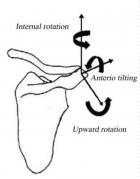
Figure 2
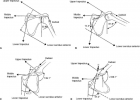
Figure 3
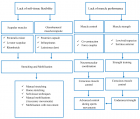
Figure 4
Similar Articles
-
A trial of conservative care for restoring scapular dyskinesis: A clinical seriesS Thiruvarangan*,P Srigrishna,B Thileebphan. A trial of conservative care for restoring scapular dyskinesis: A clinical series. . 2020 doi: 10.29328/journal.jnpr.1001031; 4: 011-015
Recently Viewed
-
Effect of sperm DNA fragmentation on ICSI outcome: A prospective studySaravanan Lakshamanan,Saravanan Mahalakshmi,Harish Ramya,Sharma Nidhi*. Effect of sperm DNA fragmentation on ICSI outcome: A prospective study. Clin J Obstet Gynecol. 2020: doi: 10.29328/journal.cjog.1001065; 3: 127-131
-
Forensic analysis of private browsing mechanisms: Tracing internet activitiesHasan Fayyad-Kazan*,Sondos Kassem-Moussa,Hussin J Hejase,Ale J Hejase. Forensic analysis of private browsing mechanisms: Tracing internet activities. J Forensic Sci Res. 2021: doi: 10.29328/journal.jfsr.1001022; 5: 012-019
-
A study of coagulation profile in patients with cancer in a tertiary care hospitalGaurav Khichariya,Manjula K*,Subhashish Das,Kalyani R. A study of coagulation profile in patients with cancer in a tertiary care hospital. J Hematol Clin Res. 2021: doi: 10.29328/journal.jhcr.1001015; 5: 001-003
-
Viral meningitis in pregnancy: A case reportRuth Roseingrave*,Savita Lalchandani . Viral meningitis in pregnancy: A case report. Clin J Obstet Gynecol. 2020: doi: 10.29328/journal.cjog.1001063; 3: 121-122
-
Vaginal and endometrial metastasis of primary cutaneous malignant melanomaMaria Boia Martins*,Francisca Morgado,Nuno Oliveira,Filomena Ramos. Vaginal and endometrial metastasis of primary cutaneous malignant melanoma. Clin J Obstet Gynecol. 2020: doi: 10.29328/journal.cjog.1001062; 3: 120-120
Most Viewed
-
Evaluation of Biostimulants Based on Recovered Protein Hydrolysates from Animal By-products as Plant Growth EnhancersH Pérez-Aguilar*, M Lacruz-Asaro, F Arán-Ais. Evaluation of Biostimulants Based on Recovered Protein Hydrolysates from Animal By-products as Plant Growth Enhancers. J Plant Sci Phytopathol. 2023 doi: 10.29328/journal.jpsp.1001104; 7: 042-047
-
Sinonasal Myxoma Extending into the Orbit in a 4-Year Old: A Case PresentationJulian A Purrinos*, Ramzi Younis. Sinonasal Myxoma Extending into the Orbit in a 4-Year Old: A Case Presentation. Arch Case Rep. 2024 doi: 10.29328/journal.acr.1001099; 8: 075-077
-
Feasibility study of magnetic sensing for detecting single-neuron action potentialsDenis Tonini,Kai Wu,Renata Saha,Jian-Ping Wang*. Feasibility study of magnetic sensing for detecting single-neuron action potentials. Ann Biomed Sci Eng. 2022 doi: 10.29328/journal.abse.1001018; 6: 019-029
-
Pediatric Dysgerminoma: Unveiling a Rare Ovarian TumorFaten Limaiem*, Khalil Saffar, Ahmed Halouani. Pediatric Dysgerminoma: Unveiling a Rare Ovarian Tumor. Arch Case Rep. 2024 doi: 10.29328/journal.acr.1001087; 8: 010-013
-
Physical activity can change the physiological and psychological circumstances during COVID-19 pandemic: A narrative reviewKhashayar Maroufi*. Physical activity can change the physiological and psychological circumstances during COVID-19 pandemic: A narrative review. J Sports Med Ther. 2021 doi: 10.29328/journal.jsmt.1001051; 6: 001-007

HSPI: We're glad you're here. Please click "create a new Query" if you are a new visitor to our website and need further information from us.
If you are already a member of our network and need to keep track of any developments regarding a question you have already submitted, click "take me to my Query."







